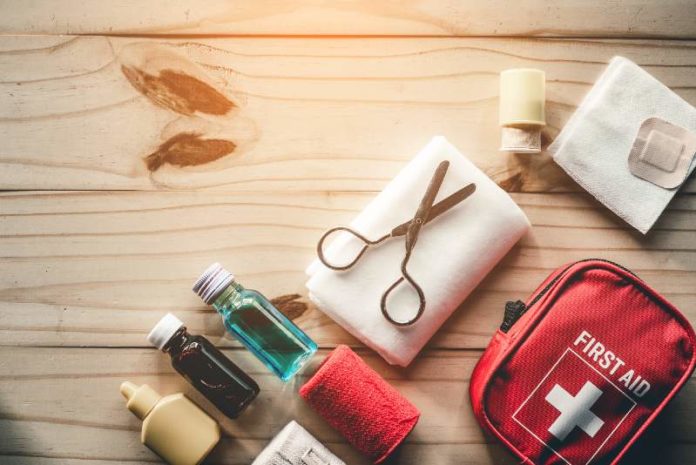An IFAK or Individual First Aid Kit is an essential part of any survivalist arsenal.
No survival pack is complete without a compact IFAK pouch. Your backpack may have all the tools and supplies you need but what if you got injured? Read on as we guide you on how to prepare the best IFAK like a pro.
Getting injured in a remote area is a difficult predicament and is bad enough. But without rescue essentials, it would be a living nightmare. In situations like this, a simple first aid pouch would spell the difference between life and death.
Before IFAK meaning Individual First Aid Kit came into mainstream use, a tactical medical backpack has been standard military equipment. The possibility of soldiers getting wounded in battle is high. This is why tactical medical bags are as important in warfare as guns and ammunition.
A tactical medical pouch is specifically devised to treat minor injuries and various ailments. Its contents are based on a specific understanding of combat situations and risks. Below are the basic items found inside a standard combat medic aid bag:
The Best Trauma Kit?
This means that SWAT medics, for instance, may use trauma kits that differ from that of an ordinary medic. Tactical first aid pouch might include airway insertions, needle decompressions, and other tools for invasive procedures. These types of medical procedures require intensive professional training.
Modern Professional First Aid Kit
State-of-the-art IFAKs may vary depending on specific conditions it may be used. Yet all modern first aid kits include a tourniquet and hemostatic agents. Hemostatic agents are items that are designed to stop excessive bleeding on patients.
Note: Generally, regulatory agencies approve the use of blood-stopping agents. Both in civilian life and military combat, bleeding is a common cause of death. However, it is preventable provided battle medics are equipped with a hemostatic agent and modern trauma supplies.
RELATED: Do You Keep A Combat Casualty Kit In Your Go Bag?
Why Do You Need a First Aid Kit?
During life-threatening emergencies, the most common person in the area is most likely a civilian. It is not uncommon for bystanders to be injured in vehicular accidents or shooting incidents. When this happens, bleeding may occur and the capability of another civilian to respond can be crucial in preserving lives.
An emergency is a major reason why even civilians should carry even a simple first aid belt pouch all the time. You will never when life and death may occur. The worst-case scenario is it may involve you and your loved ones. You would wish you have a FAK in tow but it could be too late.
Wise and Practical
This is why it is wise to have an IFAK with you at all times. Whether you are just buying groceries or going out on a trip, carrying a first aid kit would be practical. A first responder medical kit, as the cliché goes, could spell the difference between living and not living.
Customize Your IFAK
Did you know that you can even design your IFAK based on your risk profile? Yes, and apart from this you can also choose the best first aid kit suitable for your level of training. In short, your customized IFAK pouch could be an excellent insurance policy for you and your loved ones.
How To Set Up Your Compact IFAK Pouch?
Now that you know the basics of owning an IFAK, it is time to prepare your custom kit. It does not take a medical professional to set up a first aid kit. All you need to do is follow these simple guidelines:
1.Plan Your First Aid Kit
Planning your IFAK is central in enabling you to respond to life and death situations effectively. The objective is to be able to manage life-threatening incidents with minimal medical equipment. With this in mind, you can decide on the essential items for your kit.
Note: A belt-mounted medical pouch is a sensible option. This will make it easy to carry in every location. Aside from this, the small size of your medical pouch makes it easy to access during emergencies.
2.Choose the Right Items
Picking the right medical items is crucial for an effective IFAK. The best first aid kit contains the most common equipment necessary in treating typical injuries. A basic 3 x 6 IFAK contents are:
Tourniquet
Gloves
Vented chest seal
Combat (hemostatic) gauze
Burn dressing
Israeli dressings
Pressure dressing
Trauma shears
Penlight
Ibuprofen
Permanent marker
Note: Bigger 6 x 6 medical kits may include items like duct tape, extra gauze, trauma tape, control wrap, splinting material, and nasal pharyngeal airway.
3.Make Your IFAK Easy to Spot
Besides placing your kit in an accessible location, it is also important that you can easily see it. In times of emergency where everything could be a blur, this would matter most. So, if you are planning to buy or create a first aid pouch, make sure that the color is bright and easy to see such as yellow or red.
In conclusion, an IFAK functions like your personal medical assistant. It is your dependable ally that should be with you no matter when and no matter where. There is a reason why the advice “It’s better safe than sorry” never grows old. Cheers!
Up Next:
What do you think are the most important items in a first aid kit? Feel free to share your thoughts in the comment section below!
Calling all preppers, craftsmen, bushmasters, outdoorsmen, and all-around skilled people, Survival Life needs YOU! Click here if you want to write for us.
Don’t forget to stay connected with us on Facebook, Twitter, Pinterest, and Instagram!


